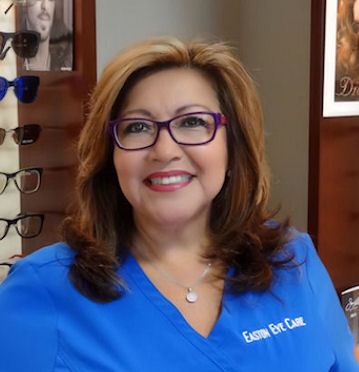
Easton Eye Care
Dr. Easton received his B.S. in Chemistry from the University of Central Florida and his Doctorate of Optometry (O.D.) from the University of Houston College of Optometry. In addition, Dr. Easton did his internship at the Bascom Palmer Eye Institute in Miami. As an Optometric Physician and South Florida native, Dr. Easton has been actively serving his profession and his community since he started his professional practice in 1986.
Past President of the Broward County Optometric Association
Past President of the Florida Optometric Association
Past Chairman of the Florida Board of Optometry
Past President of the Association of Regulatory Boards in Optometry
Fellow of the American Academy of Optometry
Diplomate of the American Board of Optometry
Past President of the Rotary Club of Downtown Fort Lauderdale
Member Florida Board of Optometry
Board Member The Hundred Club of Broward County
Ask the Doctor
-
What is Ask the Doctor?Open or Close
It is a section we created to help answer many frequently asked questions that our patients have asked. If you have any questions or concerns not covered here please contact Doctor Easton by using our contact form or by calling him at 954 564-2025
-
Frequently Asked Questions.Open or Close
Q: Do computers cause vision damage?
A: Computers represent the number-one source for workplace discomfort, but their use does not harm the visual pathway.
Vision is a passive phenomenon. Looking at the screen will not harm the eye or alter its refractive power.
Having said that, spending ALL DAY in front of a monitor can induce eyestrain or eye fatigue, dry eyes, burning eyes, light sensitivity, blurred vision, headaches and pain in the shoulders, neck or back.
Here are some proven steps that can help you avoid computer vision syndrome, and make you more comfortable at the workstation:
Turn off lights adjacent to the monitor or behind the computer. Illumination from behind the operator works best. The desktop should be 29 inches from the ground. Do not use a wrist rest for either the keyboard or the mouse. Position the monitor and/or chair height so that when LOOKING STRAIGHT AT THE MONITOR your line of sight is directly at the top edge of the screen. This generates a slight downward gaze - most comfortable for long work periods. Finally, the screen surface should be approximately 30 inches from your face in order that the intermediate portion of your trifocals focus properly without requiring excess accommodation from you.
Q: An Eye drop like Visine help clear my eyes, but is it safe to use them every day?
A: Continuous use of vasoconstrictor eye drops such as Visine is unwise.Dry eyes? Use a preservative-free artificial tear supplement.
Repeated use of vasoconstrictors causes REBOUND REDNESS. Once the drugs' chemicals wear off, the previously constricted blood vessels relax, dilate and cause even more redness.
Over time vasoconstrictors, like many eye drops, lose their potency. The eye drops fail to perform as well as when first used.
Vasoconstrictor eye drops should be used sparingly for special occasions, like an important photograph or severe allergy.
Q: What should I do for these dry eyes?
A: Let's first review what we know about wet eyes and dry eyes.
The healthy eyeball remains moist due to the presence of a three-layer tear film. The outmost layer is oil, the middle layer is water, and the tear layer closest to the cornea is mucus. Tiny, microscopic glands deep in the eyelids called the ACCESSORY LACRIMAL GLANDS produce the water layer. Do not confuse these with the big lacrimal gland above the eyeball.
If these tiny glands produce an inadequate supply of fresh water (and oxygen) to the surface of the eye, the tear film becomes toxic, just like vinegar. In response to this change, nerves on the surface of the eye sense trouble and alert the big lacrimal gland upstairs to make lots of tears to flood the surface of the eyeball. The same thing happens whenever somebody blows smoke into your face.
Here are some of the leading things that lead to decreased tear production:
ADULTHOOD - The tiny glands in the eye deteriorate with age, sometimes causing dry eye.
GENDER - Women experience far more dry eye problems. Yes! Estrogen can help reverse dry eye.
CHRONIC INFLAMMATION - Conditions like arthritis, lupus, other autoimmune conditions can cause inflammation and lead to dry eyes.
TOXIC EXPOSURE - Too much radiation, too much sunlight, too much surgery.
MEDICAMENTOSA - Reduced tear production caused by medications.
You would be well served to have Dr. Easton perform a complete dry eye evaluation. Many different conditions can cause your symptoms, and many are highly treatable.
Don't be miserable - take action!
Q: Why are my eyes so red and irritated?
A: In order for the eyes to remain happy and healthy, there has to be a continuously fresh layer of tears evenly spread across the eyeball.
Any irregularity of the tear film will immediately make the eyes uncomfortable.
Deficient blinking combined with poor tear secretion account for most of these problems.
The blink rate varies with activity. Can you guess which activity stimulates MOST and LEAST blinking?
Is it EATING?
Is it SPEAKING?
Is it READING?
We blink most when speaking, and we blink least while reading.
Computer users are very prone to this problem. Besides the low blink rate, the dry office air makes things that much more intolerable.
Force yourself to take brief breaks more often. Sit back, close your lids and relax for a few seconds. Take a sip of water. Stretch your legs. You'll be amazed how much more refreshed you feel when you return to the keyboard.
Q: Why do my eyes always burn?
A: The eyes burn because nerves on the surface of the eye are irritated.
The nerves are irritated because something is wrong with the moist surface of the eyes.
Tears furnish moisture to the ocular surface.
Now, about your problem. The most likely cause for your burning is a defective tear film: inadequate tear production, abnormal chemistry, wrong, pH, etc.
It would be wise to have Dr. Easton evaluate you. It is most likely a simple case of dry eyes, but there are other major medical problems that include tear film deficiencies.
Your physician knows what questions to ask and what diagnostic tests to perform. In the meantime, she can recommend the best treatment plan to relieve your discomfort.
-
Why am I seeing funny shapes and spots?Open or Close
The vitreous in children is very firm and gelatinous. In older folks the vitreous turns to water. That means there's a transition period during which the gel "melts." The medical term for this process is SYNERESIS.
During syneresis some of the gel is still partially formed in chunks. These free-floating chunks represent your floaters. Although they are clear, these chunks cast an optical shadow on the retina, giving them a dark appearance.
Floaters typically don't appear in colors, but floaters can appear singly or in multiples. They appear in various shapes and sizes.
The vast majority of folks with floaters do not develop retinal detachment. When the vitreous separates from the retina along the wall of our "fish tank," it can stimulate light flashes in the retina. These can be plain or colorful. Persistent or progressive flashes should alert you to get a comprehensive eye exam.
Whether you see clusters, specks, black dots, most floaters go away over time. Either the gel completely dissolves, or the chunks settle down to the bottom of the eye, or (most likely) your brain learns to simply ignore them. There is no medical therapy available to eliminate floaters.
-
What is "lazy eye?"Open or Close
The medical term for "lazy eye" is AMBLYOPIA: a healthy eye that does not see. The eye became amblyopic either because the eyes were crooked or one eye had a very different refractive error than the other. To eliminate double vision the brain preferred to use one eye only.
Patching the GOOD EYE during childhood is the most common method to force an amblyopic eye back to duty. Patching has no effect on the eye muscles per se; it simply forces the brain to use the unpatched eye.
-
Why is my eyesight at night blurry compared to the day?Open or Close
The refractive power of the eye changes in the dark. That is because the pupil dilates and changes the eye's aperture. In dim light nearsighted people become MORE nearsighted. They call this NIGHT MYOPIA. Some folks who do not need daytime glasses still need a nighttime prescription.
-
What is a stye and how should it be treated?Open or Close
A stye is also called a HORDEOLUM. It is a pimple caused by skin germs that infect the tunnel through which the eyelashes emerge. A stye is usually tender and eventually develops a pointy white head before it bursts.
A moist, hot compress will speed resolution. Antibiotics are not necessary. The stye has to drain, whether on its own or with a doctor's help. Sometimes it can grow so large that surgical drainage is advised.
